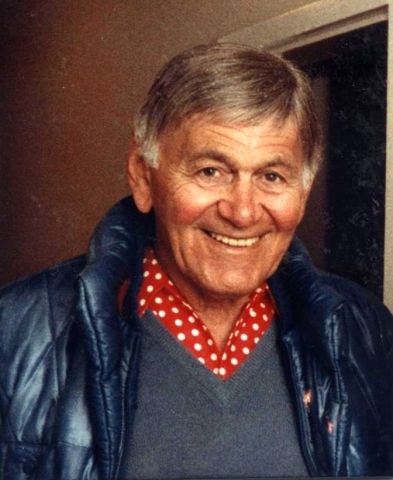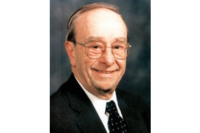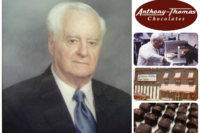
|
| Hans Arthur (John) Faerber, NID's Founder. |
As the story goes, John (Hans) Faerber – NID’s founder – first became interested in starch moulding, he quickly realized that the traditional means of handling the trays and starch just weren’t good enough.
And so, he created something better — the first NID starch moulding machine (or mogul). The machine, “displayed several features unusual at that time, including the use of screw conveyors for starch instead of bucket elevators and scrapers, a walking beam for gentle tray transport within the starch section and swinging hopper mounted over a continuous tray transport in the depositor section.”
Faerber died Thursday, Aug. 1 at 98 years old.
During his life, he was a true an innovator, and he helped progress the confectionery industry.
His daughter Esther Faerber now serves as chairman of the company he founded in 1952, after being involved in the business her whole life.
Until at least three years ago, Esther and her father spoke on a daily basis at breakfast to discuss future growth plans for NID.
In an online tribute on the The Sydney Morning Herald website, Paul Berg, of Melbourne, writes that Faerber, “should have made Australian of the Year.”
“He started in a small engineering shop using armour plate steel plate for construction material and petrol engine-driven lathe and drill to a world renowned supplier of specialist confectionery machinery displaying Australian entrepreneurship and a gamble on his ability to design and deliver,” Berg writes. “It was a great experience to work for him for 25 years, and a great help in running subsequently my own business.”
Faerber’s early life
Before starting NID, Faerber studied mechanical engineering at Technical High School, specializing in the design of printing machinery. But although he completed his studies in 1936, his career was cut short when Naziism devastated his family.
He was able to leave Germany. Originally he planned to join his mother’s family in the United States, but fate had other plans. While he was temporarily living in Welwyn Garden City, England, awaiting his U.S. entry visa, a permit and free passage to another country was offered and accepted — and thus Faerber was on his way to Australia.
Shortly after his arrival, Hans became an Australian citizen and even ended up serving in the Australian Army. He also married Ruth, and they had two children: Esther and David.
In the early 1950s, he acquired a small engineering firm and was repairing machinery for a local customer, who was manufacturing candy. Remarking that the machine seemed to be rather inefficient, he was challenged by the owner to build him a better one and thus his small workshop in Shepherd Street, Sydney started manufacturing brushing and sugar sanding machines and, soon after, small semi-automatic starch moulding machines for soft goods.
And thus, New Industrial Designs (NID) was born and eventually incorporated on Sept. 23, 1958 as NID Pty Ltd. To this day, it is the the world’s only starch moulding machinery manufacturing company to have been in the hands of one family for more than 50 years
Taking NID to the next level
Two of the major attributes of most successful businessmen are those of foresight and tenacity — and Hans had both.
He could weigh up customers’ requirements often before they knew them themselves and was frequently able, even during a first visit to a potential customer, to explain how his philosophy of mechanical simplicity could save them money.
Simplicity and clear accessibility were the hallmarks of the machines, which left both the original small workshop and ultimately the large complex of design and manufacturing halls, now in Alexandria between Sydney and its major airport.
Hans always believed that anyone who used his equipment should be able to see, understand and easily gain physical access to all major functions of the plant. Clearly, over the years, Health & Safety requirements have impinged on this to a certain extent, but the use of fail-safe devices and the stated clarity of understanding make NID machines intrinsically safe.
In the latter part of the 1950s, Hans started setting up a network of dedicated overseas sales agencies. He appointed his old friend Fred Rose of Cantab Industries as the sole North American agent and Norman Bartleet Limited as the sole UK agent, both having additional responsibilities in neighbouring territories. Within a very short time exports were far outstripping home sales, to the extent that NID was awarded Australia’s coveted Export Award several times. The M201 mogul, as starch moulding machines are generically known, was followed up in 1966 by the M301 to become a fully automatic integrated machine with its legendary ‘walking beam’ tray transport running throughout the plant and its revolutionary feeder and stacker providing production speeds never before known.
So vitally important was the substack principle of the feeding and stacking elements that others tried to avoid the patents – to their cost. From beginning, Hans had taken the wise precaution of patenting his inventions.
Hans and members of his team travelled all over the world and became among the best known and most respected in the industry.
In spite of his powerful personality and totally hands-on approach, Hans built a dedicated and skilled team within the factory and in the field, enabling him to have the confidence of knowing that quality and production targets would always be met, even while he was on extended overseas trips.
Competitors, who may have been tempted to suggest that NID was a one-man business, were countered by the obvious efficiency of the team during such periods.
Hans was an active sportsman throughout his life, as his powerful physique demonstrated, and sailing was such an all-consuming passion that he was NSW champion on more than one occasion.
Once he had passed his 90th birthday, Hans started to take a less strenuous part in company life, but still attended the design office and management meetings on a frequent basis until his eyesight started to fail. Having been delighted when his daughter Esther had joined the company, initially as a Board Member and subsequently as Chairman, Hans felt that he could now relax and let go of the reins. He died having had not only a long, but an outstandingly successful life.
Faerber was survived by his wife Ruth, his two children Esther and David, his grandchildren Jennifer, Jonathan and Sebastian and his niece Marina.
Family and friends were invited to celebrate his life and loving memory in a service held in the Palm Chapel Macquarie Park Crematorium, Cr.Delhi and Plassey Rds. North Ryde on Wed., Aug. 7 at 10.15 a.m.





